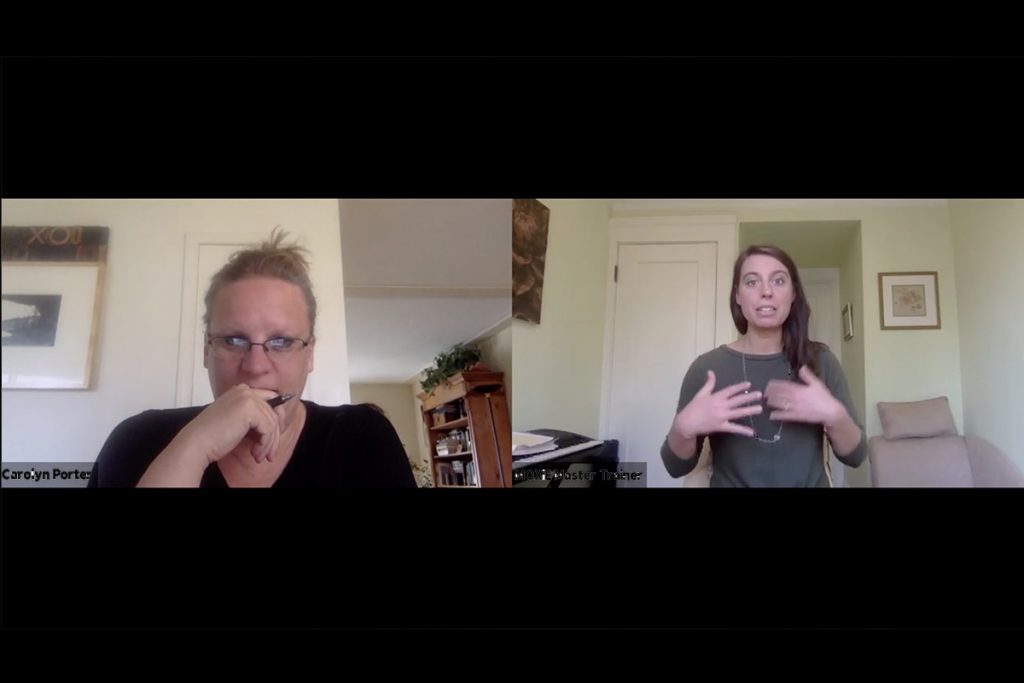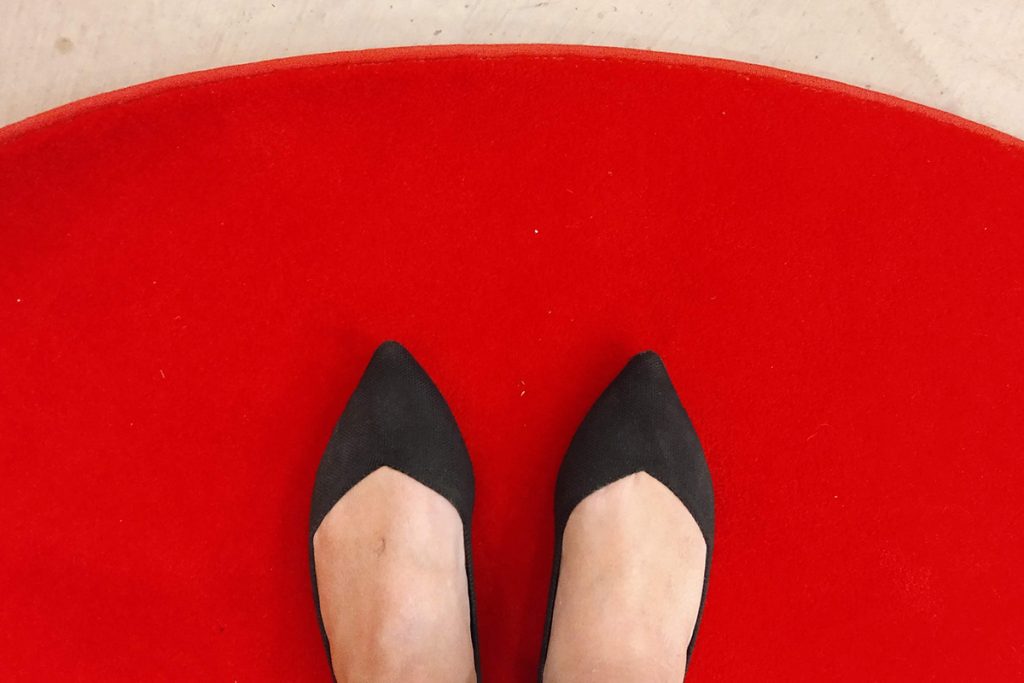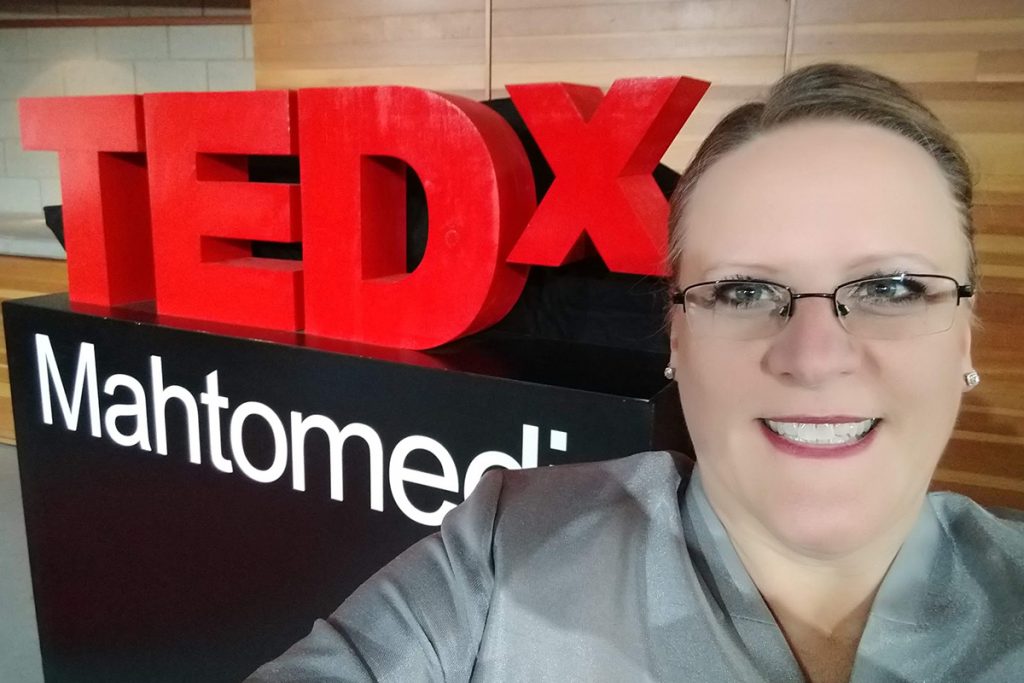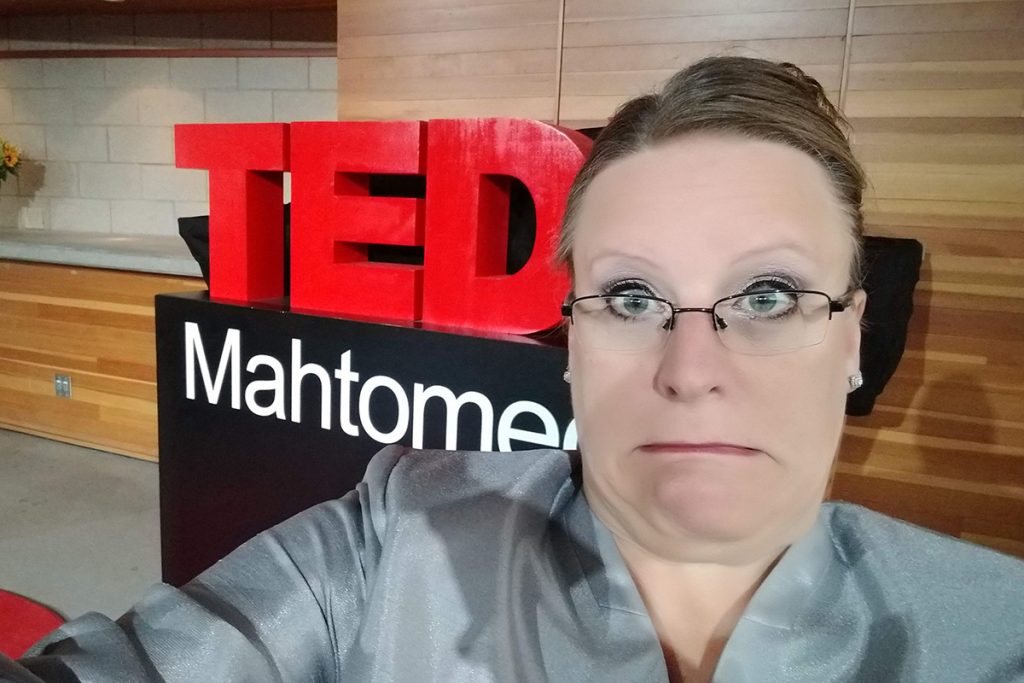Behind the scenes of my TEDx talk: one panic attack, two wobbly legs, a bit of swearing inside a church bathroom — and an incredible honor
Let’s begin with the question I’ve heard a few times about my TEDx talk: “How did it happen—were you invited? Did you apply?”
The answer is both. In early July, I received an email from a woman named Margie, one of the TEDx Mahtomedi committee members. She invited me to submit an application.
I had met Margie more than a year earlier; she attended one of the 40 or so book clubs I’ve met with for Marcel’s Letters: A Font and the Search for One Man’s Fate. We had a more personal connection, though, I learned during that book club visit: Margie had been good friends with Kathy Horton, too.
Margie and I arranged a time to chat about the potential content of a talk. Some background for those who may not know about TED talks: TED stands for Technology, Entertainment, and Design, and speakers are supposed to give the audience something meaty to think about. Think: economic theories, social issues, inventions, inspirational stories. TED talks are expressly non-promotional.
There are TED talks, and then there are TEDx talks. The official TED conference is a once-a-year, five-day conference on the west coast (2020 will be in Vancouver). In contrast, TEDx events happen all over the world. “[TEDx] typically focuses on a local community that concentrates on local voices. Officially, the ‘x’ in TEDx stands for independently organized TED event—but it’s more of a TED multiplied. It’s been the force that has taken TED across the planet and seeded all of these communities,” Mark Fidelman explained in a 2012 Forbes article.
In addition to being non-promotional, there was another big thing I had to work around. I couldn’t give a talk focused on the search for Marcel’s fate; that would have caused issues with my publisher. Margie and I discussed the possibility of the big idea being passion projects—those projects where you do or make something purely for the joy of doing or making. That provided a framework for talking about my project while also providing a larger, inspirational, TED-like message.
The initial application was due in two weeks, shortly after I was scheduled to return from San Francisco, where I taught a workshop at Letterform Archive and gave a talk at the San Francisco Public Library. I didn’t want the application hanging over my head while I was away, so I hammered out answers to the short questionnaire and submitted it the day before I left for California.
At this early point in the process, Margie made no promises my application would be selected. It would be given the same weight and attention as all of the other applications. At this early point, I also didn’t know how I felt about giving a talk. I had watched my fair share of TED videos, and I knew they were given without notes. The thought of standing on a stage without a script, without a podium to hide behind—without any sort of crutch—was terrifying. I wasn’t sure I could do it. I wasn’t sure I wanted to do it. Margie assured me I could withdraw my application if I wanted to.
A few weeks later I was invited to take part in the next round, which required an in-person audition. Twenty two of the initial applicants made it to the audition phase. I gave additional thought to how the passion project message might be relevant and impactful, then prepared a short presentation. My audition was held on a Saturday morning in late August.
The audition went okay, but I still wasn’t confident I could deliver a full-length memorized talk to a large audience. My brain is not wired for memorization. That’s not good or bad, inherently, it’s just the way my brain works.
In the foyer, after the audition, Margie and I joked that if Kathy had been there, she would have been belly laughing. Kathy would have gotten such a kick out of seeing how this story continues to launch me out of my comfort zone. Though she’s been gone for more than three years, in my mind I could hear Kathy’s laughter as clearly as if she had been standing in that foyer with us.
In late September I got the word that I was one of eight speakers* chosen for this year’s TEDx Mahtomedi conference. If I was going to back out, I needed to tell Margie immediately. From being on TV to radio interviews, to speeches and more, I’ve done more uncomfortable things in the last two years than I can count. Being selected was a huge honor and the perfect way to wrap up two years of book promotion, so I vowed to figure out how to rise to the occasion. (*One of the talks had four co-presenters; the four are lumped together as one for the purposes of counting the total number of talks.)
It was about a week before I told anyone other than Aaron; I needed to muster courage to make the announcement public. Up until that point there were only a few people who even knew about the application. Making it public made it official. And that was scary because people’s expectations for a TED/TEDx talk are so high.
I don’t have insight into the committee’s selection criteria. What I can tell you is that there was gender parity (kudos to the committee) and diverse ethnic representation. Topics included psychology, materials science, economic development, indigenous teaching, entrepreneurship, and social media. My talk fell into its own strange category of font design + obscure WWII history + an obsessive wormhole of curiosity. To this day, I don’t know what a simple one-word descriptor would be.
The committee mailed me the book, TED Talks: The Official TED Guide to Public Speaking by Chris Anderson, head of the TED organization. I devoured the book in two days and began to piece together an outline. (A friend had sent an electronic version of the book weeks earlier, closer to the time of the audition, though I didn’t have time to dig into the book at that time).
For those who have attended one of my 45-minute talks, you know there is plenty enough to talk about. Here, the challenge was to edit content down to a compelling opening, information on passion projects, the story of the design of the font, the story of Marcel’s letters, then a compelling close. All of that needed to happen in approximately 1,500 words.
A couple of weeks later I met with Margie and another committee member, Olivia, to review my outline. The working title was “The Unexpected Journey of a Passion Project.” Margie had good and specific edits that I was happy to incorporate.
In the following weeks, I carried the script around the house like a safety blanket. I dragged it from room to room as I refined and memorized the talk, stealing glances at the crinkled paper when I couldn’t remember what came next. Anyone who saw me walk Watson around the neighborhood or walk laps at the dog park likely saw and heard me practice.
–
“Please don’t come to my talk”
________________
A couple of friends reached out to inquire how they could get tickets to the TEDx event.
Their support meant a lot. Truly. But, selfishly, I did not want them there and was grateful they were close enough friends that I could tell them that. I was worried I’d see them in the audience, and that my brain would try to interpret the slightest scrunch of their eyebrows or a tiny tilt of their head. I didn’t want to give my brain fuel for distraction.
In the end, Aaron didn’t even attend. I believe I was the only speaker who didn’t have anyone there, though I knew people were rooting for me from afar.
–
Plot Twist #1
________________
I reached out to the conference team to see if I could do a technology check at the first rehearsal, which was scheduled for a Monday evening in late October. I planned to show a never-before-seen sequence of images of the font in development and wanted to ensure the images had adequate contrast.
When I’ve given presentations at conferences I’ve always submitted PDFs to accompany my talk. It’s a common file format and preferred by many because it offers design flexibility and predictable control over type.
The response did not make me happy: the only file format the person in charge of AV felt comfortable using was PowerPoint. It’s not that I can’t use PowerPoint—I don’t like to use it (and I don’t know any other designers who do). It’s rudimentary and clunky. I don’t trust it. I can’t tell you how many presentations I’ve seen where the speaker apologizes mid-presentation when something in PowerPoint goes awry.
In the end, I imported pages as full-page photos into PowerPoint. It was the only way to eliminate the possibility of surprises. But it was not ideal.
–
Monday, Oct. 24: First Official Rehearsal
________________
The first official rehearsal, along with the event itself, was held at the Unitarian Universalist Church in Mahtomedi. The sanctuary is a lovely, high-ceilinged space filled with natural wood. A wall of windows faces a grove of trees that has a brook running through it (and the occasional White Tail deer, I heard). I sat in one of the back pews and listened as other speakers ran through their talks.
When it was my turn, I took the stage, and got through three sentences when a wall of adrenaline took my breath away. My mind went blank. Zip. Zippo. Total blank out. I couldn’t remember lines I had rehearsed a hundred times. I couldn’t continue without referring to the script.
Upon reflection, I think my brain was processing too many new things at once: new people, new space, new AV setup, new stage. It was all too much.
The rehearsal provided a “safe” place to fail. And that’s what rehearsal is for, right? Still, it was a disaster, and every fear I had about delivering a memorized talk surged to the fore. I came home totally deflated.
–
Panic
________________
I woke up at 2:30am after getting less than an hour of sleep. My heart was pounding. I was trembling. I don’t know if it was a panic attack—I’ve never had one before—but it felt it could have been one.
I needed help figuring out how to deal with the surge of adrenaline and the mental blank out. I sent Margie an email: could I use note cards? (She said yes; cards were OK if needed).
The next day I searched online for “TED speaker preparation” and found a company in California, MOXiE, that specialized in high-stake, executive, and TED speaker training. Within 24 hours I had signed a contract for five one-on-one training sessions. The timeline was short, so I prioritized two specific goals: dealing with the adrenaline wall and preventing a blank out.
The price tag was steep, but I kept circling back to the fact that my talk would live forever online. I couldn’t risk humiliating myself on stage. Plus, as the MOXiE rep pointed out, I’d acquire skills I could use in future public talks.
Note: MOXiE offers small group training sessions, which cover some of the same content at a more affordable price point, but none of the classes were offered during the short window of time I had. In the end, the one-on-one training was the best thing for me anyway.
My coach, Julia, was extraordinary. During our five video sessions she helped with breathing (you would think I would have mastered breathing in the first few minutes of life, but apparently not), nerve management, body confidence, vocal warm ups, use of gestures, and vocal inflection. We also planned out how I could move a step or two during the talk’s transition points to reinforce a change in content. I was grateful for Julia’s guidance, expertise, and the kindness she demonstrated while pushing me to improve my performance. In this era when too many things feel artificial, I felt Julia and the team at MOXiE really, truly, sincerely wanted me to succeed.
Between sessions with Julia I continued to practice. I got to the point where, alone in my kitchen, I could deliver the talk backward. Seriously. (Backward by paragraph, not by word or sentence). Still, when I ran through the talk with Julia, I would get flustered, leave entire parts out, and my voice would get gravelly. It wasn’t a trendy vocal fry—it sounded more like I had been a life-long smoker. It is not pretty when that happens.
–
Run-Throughs at the Venue
________________
One thing I did to eliminate the issue of my brain processing too many new things all at once was to arrange practice sessions at the Unitarian Universalist Church. The facility manager graciously let me come twice during the lunch hour when the sanctuary was not otherwise in use. It was helpful to rehearse in the space in full voice, and over the course of two sessions I ran through the talk six times.
–
Run-Through with Friends
________________
Six days before the event, seven friends came over to our home for two practice run-throughs. In exchange, I promised wine, cheese, and play time with Watson. Giving the talk in front of actual people (not just the kitchen island) would help me practice not allowing audience expressions—scrunched eyebrows or alarmed eyes—to derail my talk.
In the end, people’s expressions during the TEDx event weren’t an issue. I could only see shadowed faces of the first two rows; beyond that, I could only see silhouettes. But I didn’t know that at the time.
After the first run-through I asked three questions: Was any content unclear? What resonated with you? What is one thing I can do to improve? (Julia cautioned getting too much feedback with only a handful of days to go could be overwhelming, hence questions that would elicit some—but not too much—feedback).
I was grateful for the practice and the feedback. I was able to incorporate specific editorial suggestions (e.g., confusion between letters in the font and the original handwritten letters), and was able to make a short list of presentation issues to discuss with Julia.
Guinea pigs (a.k.a. friends brave enough to come to the practice session): Back row, L-R: Jeanenne Rausch, Anne Mulholland Johnson, Steve Johnson, Peggy’s cousin Cindy, Laura Kennedy. On chair, L-R: Patti Isaacs and Peggy Parenteau. Foreground: Me. Not shown: Aaron, who was off to the side managing Watson, who was overly excited to have guests and food sitting out on the counter.
–
Plot Twist #2
________________
The morning after the practice session, I woke up feeling tightness behind my eyes and itchiness in my ears—the predictable and dreaded first signs of a whopping head cold that typically lasts 8–10 days, involves a bottle of NyQuil, and three or more boxes of Kleenex. I was pissed. Why couldn’t it hold off for another week?!
Friends, I have never consumed so much Vitamin C, rinsed my sinuses so often, or sucked on so many zinc lozenges as I did in the next 48 hours. I think I angered the virus away (OK, OK, I’m married to a medical professional, I know that’s not possible). But I have no other explanation for why it didn’t turn into a full-blown cold.
–
Thursday, Nov. 7: Dress Rehearsal
________________
I decided not to listen to the speakers who took the stage before me. It wasn’t that I wasn’t interested in their content or didn’t want to show support. I needed to “stay in my own head” and not allow my brain be filled with the content of their talk, like I had during the first practice session.
It was a good decision. By the time I took the stage, I felt ready and focused.
The run-through was far from perfect, though. My voice was gravelly. I forgot to forward a slide at the correct time. My legs felt wobbly, so I didn’t walk around. But I got through it. And the rehearsal provided good content to discuss the next day during my final coaching session with Julia.
The final run-through with Julia was one of the worst ever. I jumbled content. I forgot a full paragraph half-way through the talk. Worse yet, I forgot a full third of the closing section. After going through the talk hundreds of times, I had no idea why quality seemed to be regressing.
Standing inside the iconic red circle at the dress rehearsal.
–
Saturday: The Day Before
________________
I’m not one for self talk. I should clarify: I’m not one for positive self-talk. As silly as it sounds, the day before the TEDx event, I had a talk with my brain. I told my brain the audience was on my side. I reminded my brain it was a huge honor to give this talk, and that I knew my talk inside and out. I had practiced it backward for goodness sakes! I told my brain there was no need for my voice to get gravelly. And I reminded my brain something Julia told me several times: I might actually enjoy giving the talk.
Aaron was up north for the weekend, so I had the day to myself to practice and prepare. Watson and I took an extra long walk at the dog park. I carefully steamed my trousers and the new jacket I purchased for the occasion.
I went to bed early to try to get a good night’s sleep.
–
Sunday
________________
On Sunday morning, Watson and I returned to the dog park for another extra-long walk. On the way home I stopped at Starbuck’s for a fancy coffee. I ran to the grocery store, and messaged back and forth with a few friends who reached out to wish me well. Then I began getting ready.
Call time was 2:30. The photographer took group and individual portraits. I took a few selfies:
This is my Instagram-ready selfie:
But this is how I was actually feeling:
–
Plot Twist #3
________________
It wasn’t a wardrobe malfunction, per se. It was a flawed plan not previously discovered. During a trip to the restroom, I realized the way my shirt tucked into my pants combined with where the jacket closed was a really bad look. I should have known this prior to the event, but I didn’t […sigh]. I spent a few long minutes trying to figure out the best remedy. My shirt was too long to look right hanging out from underneath my jacket, but blousing the shirt didn’t work either. Had I realized this was going to be an issue, I would have worn a different shirt. Geesh, I had even planned out which bra to wear, so not testing the shirt in advance seemed like a total rookie mistake.
I may have uttered a few swear words.
Inside a church bathroom.
–
Wait
________________
Ticket holders were allowed into the sanctuary at 3:20; the event began ten minutes later. The first five speakers would be followed by an intermission with drinks, appetizers, and discussion, followed by the final three speakers. I was scheduled to speak fourth.
As the first speaker took the stage, I waited with speakers #2, #3 and #5 in a narrow, wedge-shaped room behind the church’s pulpit. I wore noise-canceling headphones in an effort to “stay in my own head” but they were only partially successful. It was impossible not to be aware of the stage on the opposite side of the wall. My heart lurched and pounded. At one point I started seeing white spots, so I sat down and took the deep, full-lung breaths Julia taught me.
A downside to waiting in the room was that we had to be nearly silent. Vocal warm-ups weren’t possible. I couldn’t do jumping jacks like Julia suggested to release nervous energy. But, the benefit to having us be behind the stage was that when it was time, we could appear on stage right on cue.
–
Show Time
________________
How did it go? You can see for yourself by watching the talk. I’ve included a link below.
How do I think it went? Mostly great. I remembered the entire script—yeah! I forwarded all the slides at the correct time—yeah! Almost miraculously, my voice didn’t get gravelly.
I will always be my worst critic, so I will admit it wasn’t perfect. I say the talk was only “mostly” great because my legs were shaking. Not just shaking—they felt like jelly. The small steps to mark transitions in the talk didn’t materialize. I remained planted on stage. I feared if I took a step to the side there was a real possibility I’d tip right over. At one point I realized I was holding the remote control in both hands, which was a gesture of “hiding” on stage. And I was still self-conscious about my shirt.
But, given the option of getting through the talk without mistakes or incorporating all of Julia’s best-case scenario performance suggestions, I will celebrate the fact the talk itself went well. I know full well people in the audience couldn’t see my legs shake, and probably didn’t pay much attention to how I unclasped my hands once I became aware of how I was holding the remote.
In the end, the point of the talk was to inspire people, take them on a journey of discovery, and introduce them to the amazing, love-filled letters of Marcel Heuzé.
By those measures, it was a success.
A huge thank you to the organizing committee and volunteers of TEDx Mahtomedi. It was an honor to be one of your 2019 speakers!







carolyn
December 3, 2019 at 1:50 amThanks, Christy!
Christy Nesja
December 3, 2019 at 1:47 amThanks for sharing the whole back story on TEDx and how everything came to be. I can’t wait to see your recorded talk when it is ready. Great job stepping out of your comfort zone and taking this on with gusto!
carolyn
December 2, 2019 at 7:43 pmThanks, Susan!
Susan Mertesdorf
December 2, 2019 at 5:46 pmCongratulations on getting through the talk and taking a huge step out of your comfort zone.
carolyn
December 2, 2019 at 3:15 pmThanks, Laura!
Laura Davies
December 2, 2019 at 3:09 pmHow incredible! I empathize with all your anxiety and take encouragement from you on how you faced your fears and was successful!!
carolyn
December 2, 2019 at 2:46 pmThanks, Emily! You know more than a few things about launching yourself w-a-y outside your comfort zone and mustering courage to challenge yourself, so it’s quite a compliment you were able to take something from this blog!
Emily Schulzetenberg
December 2, 2019 at 1:49 pmThanks for taking us behind the curtain of your preparation. After watching countless TED and TEDx talks myself, it really puts into perspective how much work and energy is put in behind the scenes for presentations like this. I’m so inspired by your courage to challenge yourself.
What impressed me most is not that you just powered through the fear (though you did), but you put specific strategies and boundaries in place (speaker coaching, extra onsite rehearsals, asking that friends and family do not attend, etc.) to ensure you were the most prepared and confident you could be. Those decisions show that you prioritized the things you could control and let go of the things you couldn’t. I think that’s a message often missed when talking about facing your fears. There needs to be balance of preparation and courage and I think you illustrate that wonderfully with this personal triumph.
Congrats and I can’t wait to see the talk!
carolyn
December 2, 2019 at 2:56 amThanks again for coming to the practice session, Anne! You’ll be happy to hear that I took one of your very specific comments (re: using the word “paper” when talking about the original letters) and remembered to use that language in the final presentation!
carolyn
December 2, 2019 at 2:54 amThank you, Juanita! I figure all I can do is be honest about the good, the bad, the ugly, and the messy in-between!
Juanita Harder
December 2, 2019 at 2:35 amCarolyn, You always amaze me with the transparency and vulnerabilities you share as you make your way through this journey. Congratulations on another experience braced!
Anne Johnson
December 2, 2019 at 1:27 amGreat to read the entire story from beginning to end. You are the best, Carolyn!